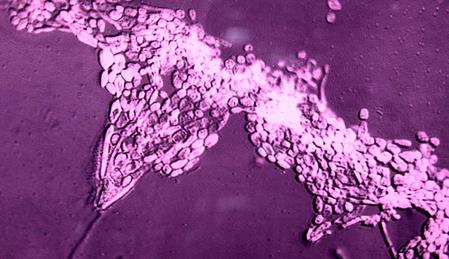ICMR Researchers Develop New Approach To Tackle Fungal Pathogens
Candida albicans is the primary cause of systemic candidiasis -- a major global health threat with a high mortality rate up to 63.6 per cent in severe cases.
The researchers, including those from Wadhwani School of Data Science and AI (WSAI) and Indian Institute of Technology (IIT) Madras, developed a multidisciplinary approach to identify some of the critical metabolic pathways that can be targeted to modulate the virulence of the pathogen.
The team combined large-scale computational modelling and experimental validation to identify unknown critical metabolic vulnerabilities in CAL.
“Unlike other studies, the one-of-a-kind integrated host-fungal metabolic model combined the CAL model iRV781 with the human metabolic model Recon3D,” said corresponding author and principal investigator Dr. Susan Thomas from ICMR-NIRRCH, Mumbai.
This allowed the researchers to simulate how CAL metabolism responds during a host infection, identify and reveal hidden metabolic vulnerabilities not evident in laboratory cultures, and highlight the role of arginine metabolism in CAL pathogenicity, Thomas explained.
“The groundbreaking novel research is vital for diversifying and improving antifungal drugs to bypass resistance. Further, it aims to improve patient survival, reduce mortality, and lower treatment costs,” added Prof. Karthik Raman, Faculty, IBSE, WSAI, IIT Madras.
The findings, published in the reputed peer-reviewed journal Cell Communication and Signaling, also underline India's growing strength in interdisciplinary research and its potential to contribute solutions.
Candida albicans is a species of fungus (yeast) that normally lives in the human body as part of the normal microbiota. It is commonly found in the mouth, throat, gut, vagina, and on the skin without causing harm in healthy individuals.
It causes 'Systemic candidiasis', a severe, invasive fungal infection caused by Candida species (most often Candida albicans) that spreads beyond the mouth, skin, or genital area into the bloodstream and internal organs.
The annual incidence of invasive candidiasis in India is about 470,000 or 34/100,000 population. Globally, about 15,65,000 people have a Candida bloodstream infection or invasive candidiasis each year, with 995,000 deaths (63·6 per cent).

Legal Disclaimer:
MENAFN provides the
information “as is” without warranty of any kind. We do not accept
any responsibility or liability for the accuracy, content, images,
videos, licenses, completeness, legality, or reliability of the information
contained in this article. If you have any complaints or copyright
issues related to this article, kindly contact the provider above.
Most popular stories
Market Research

- Pluscapital Advisor Empowers Traders To Master Global Markets Around The Clock
- Invromining Expands AI Quant Infrastructure To Broaden Access To Digital Asset Strategies
- Cartesian Launches First Outsourced Middle-Back-Office Offering For Digital Asset Funds
- Permissionless Data Hub Baselight Taps Walrus To Activate Data Value Onchain
- PLPC-DBTM: Non-Cellular Oncology Immunotherapy With STIPNAM Traceability, Entering A Global Acquisition Window.
- Primexbt Launches Empowering Traders To Succeed Campaign, Leading A New Era Of Trading






















Comments
No comment